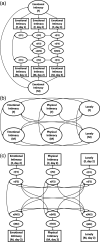COVID-19 distress and interdependence of daily emotional intimacy, physical intimacy, and loneliness in cohabiting couples
- PMID: 37578210
- PMCID: PMC9163657
- DOI: 10.1177/02654075221106391
COVID-19 distress and interdependence of daily emotional intimacy, physical intimacy, and loneliness in cohabiting couples
Abstract
Introduction: COVID-19 has had a profound impact on relationship functioning, though effects have been heterogeneous. Reasons for divergent effects on relationship functioning remain unclear. Theoretical models suggest that it is not just stress exposure that leads to adverse relationships outcomes, but also subjective response to these stressors. Using data from a 14-day intensive longitudinal study of romantic dyads, we hypothesized that COVID-19-related distress would adversely impact one's own and one's partner's report of relationship functioning, on average. Interdependence at the between-couple and within-couple level was also examined.
Methods: Participants were 104 female-male romantic couples cohabiting the New York metropolitan area (Mage = 28.86, SDage = 7.69) between August 2020 - April 2021. Couples reported COVID-19 distress during a baseline interview and daily relationship functioning for 14 days. Multilevel models were specified for six outcomes simultaneously: female and male partner daily physical intimacy, emotional intimacy, and loneliness. Interrelationships of the intercepts of the six outcomes were specified, reflecting between-couple associations of each partner's stable outcome tendencies. Interrelationships of the daily residuals of the six outcomes were also specified, reflecting within-couple associations at the daily level.
Results: Female partner COVID-19 distress was inversely associated with her own emotional and physical intimacy and positively associated with her own and her partner's loneliness. Male COVID-19 distress was associated with his own loneliness only. There was significant interdependence at the between- and within-couple level, such that greater loneliness in either partner was associated with less intimacy in each member of the couple.
Discussion: Only one partner effect for COVID-19 distress emerged, such that female partner distress was associated with male partner loneliness; however, interdependence at the between- and within-couple level suggested that distress may adversely impact relational well-being over time. Future studies should examine reciprocal relationships between COVID-19-related distress and relationship functioning.
Keywords: COVID-19; couples; daily diary methods; interdependence; intimacy; loneliness; relationship functioning.
Figures

Similar articles
-
A longitudinal analysis of intimacy processes and psychological distress among couples coping with head and neck or lung cancers.J Behav Med. 2012 Jun;35(3):334-46. doi: 10.1007/s10865-011-9349-1. Epub 2011 May 10. J Behav Med. 2012. PMID: 21556790 Free PMC article.
-
Internalized homonegativity moderates the association between attachment avoidance and emotional intimacy among same-sex male couples.Front Psychol. 2023 Mar 29;14:1148005. doi: 10.3389/fpsyg.2023.1148005. eCollection 2023. Front Psychol. 2023. PMID: 37063530 Free PMC article.
-
Yours, mine, or ours? Dyadic sleep hygiene and associations with sleep quality, emotional distress, and conflict frequency in mixed-gender, bed-sharing couples.J Sleep Res. 2024 May;33(3):e14047. doi: 10.1111/jsr.14047. Epub 2023 Sep 25. J Sleep Res. 2024. PMID: 37749792
-
What Factors are Associated with Sexual Satisfaction, Distress, and Function in Couples? A Systematic Scoping Review of Dyadic Diary Studies.J Sex Res. 2025 Apr 10:1-18. doi: 10.1080/00224499.2025.2486475. Online ahead of print. J Sex Res. 2025. PMID: 40208220 Review.
-
A meta-analytic study of partner phubbing and its antecedents and consequences.Front Psychol. 2025 May 13;16:1561159. doi: 10.3389/fpsyg.2025.1561159. eCollection 2025. Front Psychol. 2025. PMID: 40432797 Free PMC article. Review.
Cited by
-
Emphasizing the Social in Social Emotion Regulation: A Call for Integration and Expansion.Affect Sci. 2024 Sep 7;5(3):173-178. doi: 10.1007/s42761-024-00260-2. eCollection 2024 Sep. Affect Sci. 2024. PMID: 39391346 Review.
-
What Does a Pregnancy Loss Mean for Sex? Comparing Sexual Well-Being Between Couples With and Without a Recent Loss.Arch Sex Behav. 2024 Jan;53(1):423-438. doi: 10.1007/s10508-023-02697-1. Epub 2023 Oct 9. Arch Sex Behav. 2024. PMID: 37814102
References
-
- Acker M., Davis M. H. (1992). Intimacy, passion and commitment in adult romantic relationships: A test of the triangular theory of love. Journal of Social and Personal Relationships, 9(1), 21–50, 10.1177/0265407592091002 - DOI
-
- Ahorsu D. K., Imani V., Lin C.-Y., Timpka T., Broström A., Updegraff J. A., Arestedt K., Griffiths M. D., Pakpour A. H. (2020). Associations between fear of COVID-19, mental health, and preventive behaviours across pregnant women and husbands: An actor-partner interdependence modelling. International Journal of Mental Health and Addiction, 20, 1–15, 10.1007/s11469-020-00340-x - DOI - PMC - PubMed
-
- American Psychological Association . (2012). Gender and stress [Press release]. https://www.apa.org/news/press/releases/stress/2010/gender-stress
Grants and funding
LinkOut - more resources
Full Text Sources
Miscellaneous
